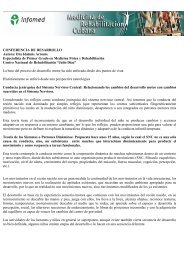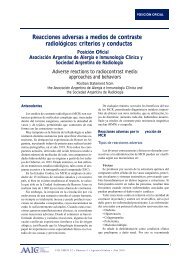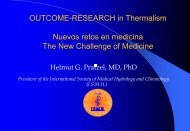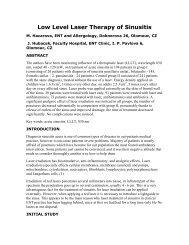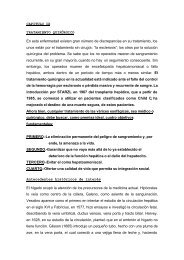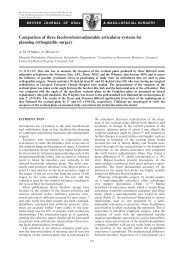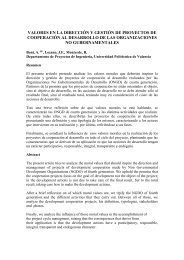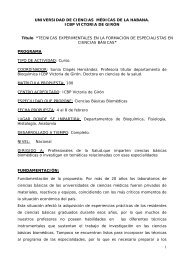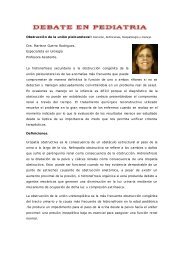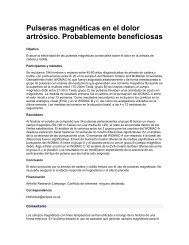Perioperative Anaphylaxis
Perioperative Anaphylaxis
Perioperative Anaphylaxis
Create successful ePaper yourself
Turn your PDF publications into a flip-book with our unique Google optimized e-Paper software.
<strong>Perioperative</strong> <strong>Anaphylaxis</strong> 439<br />
Patients who have shown clinical signs suggesting an allergic reaction during<br />
a previous anesthesia<br />
Patients who have presented with the clinical manifestations of allergy when<br />
exposed to latex, regardless of the circumstances in which this occurred<br />
Children who have had multiple operations, especially those with spina bifida,<br />
because of the high frequency of sensitization to latex and the high incidence<br />
of anaphylactic shock caused by latex in such patients<br />
Patients who have experienced clinical manifestations of allergy to avocado, kiwi,<br />
banana, chestnut, and buckwheat because of the high frequency of cross-reactivity<br />
with latex<br />
In contrast, according to this recommendation, patients who are allergic to a drug or<br />
other product that is not likely to be used during the course of the anesthesia or who<br />
are atopic (eg, those with asthma or hay fever) should not be considered at risk for<br />
perioperative anaphylaxis. 2 Other recommendations consider patients with a history<br />
of hay fever, rhinitis, asthma, or eczema (atopy) as being at risk for latex allergy. 66<br />
INVESTIGATION OF AN ALLERGIC REACTION<br />
Any suspected hypersensitivity reaction during anesthesia must be extensively investigated<br />
using combined perioperative and postoperative testing to confirm the nature<br />
of the reaction, to identify the responsible drug, to detect possible cross-reactivity in<br />
cases of anaphylaxis to an NMBA, and to provide recommendations for future anesthetic<br />
procedures. 2,67 Although serious attempts have been made to standardize and<br />
validate in vitro and in vivo techniques for the diagnosis of drug allergy, 2,65,67–69 none<br />
of the available diagnostic tests demonstrate absolute accuracy. False-positive test<br />
results may merely cause an inconvenience (unnecessary avoidance of a safe drug),<br />
whereas false-negative or equivocal results may be extremely dangerous and severely<br />
undermine correct secondary prevention. The problem in the assessment of the reliability<br />
of tests is that, when a single diagnostic test is negative, it is impossible to<br />
determine whether it is a false-negative test or whether the patient is tolerant to the<br />
tested agent unless the agent is administered. Whenever possible, confirmation of<br />
the incriminated allergen should be based on immunologic assessment using more<br />
than one test. In the event of discrepancies between different tests, an alternative<br />
compound that was completely negative in tests is advocated.<br />
The diagnostic strategy is based on a detailed history including concurrent<br />
morbidity, previous anesthetic history, and any known allergies, and a combination<br />
of investigations performed both immediately and days to weeks later. Biologic investigations<br />
include mediator release assays at the time of the reaction, 70 quantification of<br />
specific IgE immediately or 6 weeks later, 70,71 skin tests, 68 and other biologic assays<br />
such as histamine release tests or basophil activation assays. 69,72 Early tests are<br />
essentially designed to determine whether an immunologic mechanism is involved.<br />
Delayed skin tests attempt to identify the responsible drug.<br />
HISTAMINE AND TRYPTASE<br />
During an IgE-mediated reaction, basophils and mast cells are activated and then<br />
degranulate and release mediators in intracellular fluids. These mediators can be<br />
measured in the patient’s serum and have proved to be useful for the diagnosis of<br />
anaphylaxis during anesthesia. 15,62,70,73,74 Histamine concentrations are maximal<br />
almost immediately and decrease thereafter with a half-life of about 20 minutes; therefore,<br />
circulating levels should be assayed within the first hour of a reaction, and, in mild



